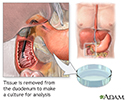Small intestine aspirate and culture
Small intestine aspirate and culture is a lab test to check for infection in the small intestine.
How the Test is Performed
A sample of fluid from the small intestine is needed. A sample is taken during an upper endoscopy (esophagogastroduodenoscopy, also called an EGD).
Esophagogastroduodenoscopy
Esophagogastroduodenoscopy (EGD) is a test to examine the lining of the esophagus, stomach, and first part of the small intestine (the duodenum)....

The fluid is placed in a special dish in the laboratory. It is watched for growth of bacteria or other organisms. This is called a culture.
How the Test will Feel
You are not involved in the test once the sample is taken.
Why the Test is Performed
Your health care provider may order this test if you have signs of too much bacteria growing in the intestinal tract. In most cases, other tests are done first. This test is rarely done outside of a research setting. In most cases, it has been replaced by a breath test that checks for excess bacteria in the small bowel.
Normally, small amounts of bacteria are present in the small intestine and they do not cause disease. However, the test may be done when your provider suspects that excess growth of intestinal bacteria is causing diarrhea.
Normal Results
No bacteria should be found.
Normal value ranges may vary slightly among different laboratories. Talk to your provider about the meaning of your specific test results.
What Abnormal Results Mean
Abnormal results may be a sign of infection.
Risks
There are no risks associated with a laboratory culture. The risks of the EGD procedure include:
- Bleeding
- Perforation of (poking a hole in) the gastrointestinal tract by the scope
- Infection
Some people may not be able to have this test because of other medical conditions.
References
Höegenauer C, Hammer HF. Maldigestion and malabsorption. In: Feldman M, Friedman LS, Brandt LJ, eds. Sleisenger and Fordtran's Gastrointestinal and Liver Disease. 11th ed. Philadelphia, PA: Elsevier; 2021:chap 104.
Lacy BE, DiBaise JK. Small intestinal bacterial overgrowth. In: Feldman M, Friedman LS, Brandt LJ, eds. Sleisenger and Fordtran's Gastrointestinal and Liver Disease. 11th ed. Philadelphia, PA: Elsevier; 2021:chap 105.
Mathison BA, Pritt BS. Medical parasitology. In: McPherson RA, Pincus MR, eds. Henry's Clinical Diagnosis and Management by Laboratory Methods. 24th ed. Philadelphia, PA: Elsevier; 2022:chap 65.
Semrad CE. Approach to the patient with diarrhea and malabsorption. In: Goldman L, Cooney KA, eds. Goldman-Cecil Medicine. 27th ed. Philadelphia, PA: Elsevier; 2024:chap 126.
-
Duodenal tissue culture - illustration
A duodenal tissue biopsy is performed by inserting a special tube through the nose or mouth down into the duodenum. When the tube is in place, it suctions out some of the fluid located in the duodenum. When the procedure is over the tube is removed. The sample is sent to the laboratory for testing. The test is performed to see if a bacterial infection is present or if there are any other microorganisms present that could be causing infection.
Duodenal tissue culture
illustration
-
Duodenal tissue culture - illustration
A duodenal tissue biopsy is performed by inserting a special tube through the nose or mouth down into the duodenum. When the tube is in place, it suctions out some of the fluid located in the duodenum. When the procedure is over the tube is removed. The sample is sent to the laboratory for testing. The test is performed to see if a bacterial infection is present or if there are any other microorganisms present that could be causing infection.
Duodenal tissue culture
illustration
Review Date: 6/11/2024
Reviewed By: Jenifer K. Lehrer, MD, Department of Gastroenterology, Aria - Jefferson Health Torresdale, Jefferson Digestive Diseases Network, Philadelphia, PA. Review provided by VeriMed Healthcare Network. Also reviewed by David C. Dugdale, MD, Medical Director, Brenda Conaway, Editorial Director, and the A.D.A.M. Editorial team.


